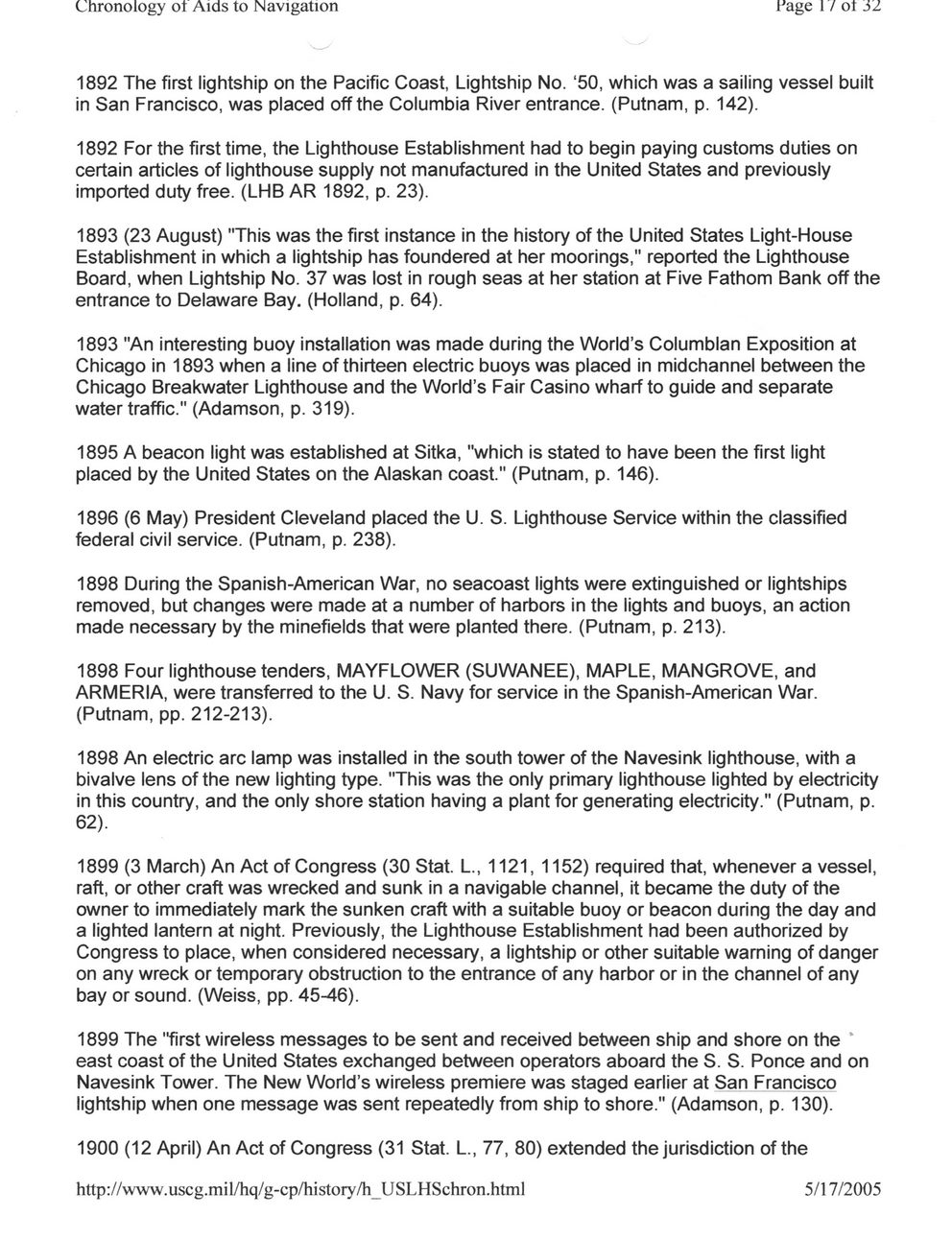This text was obtained via automated optical character recognition.
It has not been edited and may therefore contain several errors.
Chronology 01 Aids to Navigation Page 1 / ot 32 1892 The first lightship on the Pacific Coast, Lightship No. ‘50, which was a sailing vessel built in San Francisco, was placed off the Columbia River entrance. (Putnam, p. 142). 1892 For the first time, the Lighthouse Establishment had to begin paying customs duties on certain articles of lighthouse supply not manufactured in the United States and previously imported duty free. (LHB AR 1892, p. 23). 1893 (23 August) "This was the first instance in the history of the United States Light-House Establishment in which a lightship has foundered at her moorings," reported the Lighthouse Board, when Lightship No. 37 was lost in rough seas at her station at Five Fathom Bank off the entrance to Delaware Bay. (Holland, p. 64). 1893 "An interesting buoy installation was made during the World’s Columbian Exposition at Chicago in 1893 when a line of thirteen electric buoys was placed in midchannel between the Chicago Breakwater Lighthouse and the World’s Fair Casino wharf to guide and separate water traffic." (Adamson, p. 319). 1895 A beacon light was established at Sitka, "which is stated to have been the first light placed by the United States on the Alaskan coast." (Putnam, p. 146). 1896 (6 May) President Cleveland placed the U. S. Lighthouse Service within the classified federal civil service. (Putnam, p. 238). 1898 During the Spanish-American War, no seacoast lights were extinguished or lightships removed, but changes were made at a number of harbors in the lights and buoys, an action made necessary by the minefields that were planted there. (Putnam, p. 213). 1898 Four lighthouse tenders, MAYFLOWER (SUWANEE), MAPLE, MANGROVE, and ARMERIA, were transferred to the U. S. Navy for service in the Spanish-American War. (Putnam, pp. 212-213). 1898 An electric arc lamp was installed in the south tower of the Navesink lighthouse, with a bivalve lens of the new lighting type. "This was the only primary lighthouse lighted by electricity in this country, and the only shore station having a plant for generating electricity." (Putnam, p. 62). 1899 (3 March) An Act of Congress (30 Stat. L., 1121, 1152) required that, whenever a vessel, raft, or other craft was wrecked and sunk in a navigable channel, it became the duty of the owner to immediately mark the sunken craft with a suitable buoy or beacon during the day and a lighted lantern at night. Previously, the Lighthouse Establishment had been authorized by Congress to place, when considered necessary, a lightship or other suitable warning of danger on any wreck or temporary obstruction to the entrance of any harbor or in the channel of any bay or sound. (Weiss, pp. 45-46). 1899 The "first wireless messages to be sent and received between ship and shore on the ‘ east coast of the United States exchanged between operators aboard the S. S. Ponce and on Navesink Tower. The New World’s wireless premiere was staged earlier at San Francisco lightship when one message was sent repeatedly from ship to shore." (Adamson, p. 130). 1900 (12 April) An Act of Congress (31 Stat. L., 77, 80) extended the jurisdiction of the http://www.uscg.mil/hq/g-cp/history/h_USLHSchron.html 5/17/2005

Lighthouses Chronology-of-Aids-to-Navigation-(17)